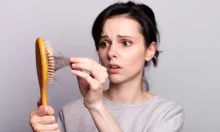Female Pattern Baldness Causes
Androgenetic alopecia, commonly known as female pattern baldness, is the predominant form of female hair thinning. Hair thinning on the scalp causes this condition. Mostly noticeable in the top and crown areas.
Female Pattern Baldness results in bald spots while preserving the receding hair line like in Male Pattern Baldness. The broader part, and an overall reduction in hair density.
Understanding the reasons for thinning hair in women is crucial in addressing this concern. Statistics from the American Academy of Dermatology shows, 50% of women may experience female pattern baldness by age 80.
The role of genetic and hormonal factors play a major role in sensitivity to the hormone dihydrotestosterone (DHT). This sensitivity contributes to the thinning or miniaturization of hair follicles. It also culminates in the production of finer and shorter strands, which are key hair fall reasons in females.
Female pattern baldness can be emotionally impactful, requiring professional intervention to identify the cause of hair loss in women. While common, consulting with dermatologists or specialized trichologists offers a pathway to effectively manage and address the condition.
Treatment options include topical minoxidil and oral medications. In rare cases, the doctor advises a hair transplant surgery for women. Women undergoing heavy loss of hair must consult healthcare professionals. They should opt for a tailored approach to their specific circumstances which addresses the type of hair loss.
Cause of Hair Fall in Women (FPB)
:Understanding the Reasons For Hair Loss in Women
-
Genetics
:Genetics is one of the reasons for female hair shedding. Specific genes can influence the sensitivity of hair follicles to hormones, making some individuals more prone to hair loss. Understanding the hereditary component is crucial in comprehending the onset and progression of FPB.
-
Hormonal Imbalance
:Fluctuations in hormone levels, particularly estrogen and testosterone, contribute to major female baldness reasons. Hormonal imbalances can impact the hair growth cycle, leading to increased hair shedding and reduced follicular vitality. Exploring these hormonal dynamics is key to understanding the causes of hair shedding in women.
-
Dihydrotestosterone (DHT)
:Dihydrotestosterone (DHT) is a potent hormone that causes the shrinkage of hair follicles, resulting in thinning hair. Understanding the mechanisms by which DHT affects follicular size and function provides essential insights into the progression of FPB.
-
Medical Conditions:
:
Female Pattern Baldness (FPB) associates with various medical conditions. Thyroid issues are one common link. Hair loss in women with PCOS is prevalent. Frequently, Several autoimmune disorders links to Female Pattern Baldness.
Investigating the connections between these health issues and FPB sheds light on the mixed nature of female hair loss. PCOS and baldness are particularly noteworthy in understanding hair loss reasons in females. -
Stress
:Stress exerts physiological effects on hair growth and extreme hair loss in women. Understanding the relationship between stress hormones and the hair follicle cycle is crucial. It comprehends the impact of stress on FPB.
-
Nutritional Deficiencies
:Deficiencies in essential nutrients like iron and vitamin D can adversely affect hair health. It contributes to the development of thinning hair and PCOS. Briefly highlighting the role of nutrition in maintaining optimal hair condition adds a comprehensive dimension to understanding FPB.
-
Other Potential Causes
:Additionally, In females, aging, scalp infections, and exposure to environmental toxins are that are responsible for Alopecia causes in females. Acknowledging these diverse influences is imperative in providing a holistic approach to addressing and managing female hair shedding. Understanding the reasons for thinning hair in females involves consideration of various aspects. It includes hair loss caused in females and other things that cause hair loss in women.
Psychological and Emotional Factors in Female Pattern Baldness
:
Emotional Impact
:Female Pattern Baldness may cause a big emotional impact. It may even affect self-esteem and mental health. The visible changes in appearance may lead to feelings of self-consciousness, embarrassment, and even anxiety or depression. Understanding the emotional toll is crucial for a holistic approach to managing FPB.
Self-esteem
:The visible signs of hair loss can significantly impact self-esteem. People with FPB often struggle with how they see themselves, affecting their confidence. Acknowledging and addressing these emotional aspects is vital for comprehensive care.
Mental Health
:The effects of FPB on mental health extend beyond self-esteem. Some individuals experience heightened stress and emotional distress. The treatment that integrates mental health while treating female hair loss is essential. It promotes well-being throughout the FPB journey.
It's crucial to recognize that treating FPB extends beyond medical interventions. Addressing psychological factors is equally important for a well-rounded approach to care. Supporting individuals emotionally can enhance their overall quality of life and contribute to a more positive experience during the management of FPB.
Complementary to Medical Treatment Option
:Emphasizing the importance of addressing psychological factors alongside medical treatment is key. Integrating counseling, support groups, or therapy into the overall care plan can enhance the effectiveness of medical interventions and foster a more resilient mindset in individuals facing FPB.
Holistic Approach
:Taking a holistic approach to FPB involves recognizing the interconnectedness of physical and emotional well-being. Combining medical treatments with emotional support can empower individuals to navigate the challenges of FPB with greater resilience and a more positive outlook.
Support Systems
:Establishing robust support systems, both professionally and personally, is crucial for those experiencing FPB. Encouraging open communication about emotional challenges and providing resources for coping strategies can contribute significantly to overall mental health and well-being.
Homeopathy and Female Pattern Baldness
:Homeopathy offers an effective hair growth treatment for Female Pattern Baldness (FPB), characterized by specific hair loss patterns. Especially for patients with conditions like Polycystic Ovary Syndrome (PCOS). Homeopathy can help by treating root causes like hormonal imbalances with personalized care.
How Homeopathy Addresses Hair Loss?
- Comprehensive Homeopathic Consultation:
The process commences with a thorough analysis of one's medical history, lifestyle, and emotional experiences associated with hair loss. Homeopaths identify triggers such as hormonal imbalances or stress, enabling them to customize a treatment plan with individualized remedies.
Regular check-ins enable adjustments based on the patient's response. Homeopaths may also advise on lifestyle and diet changes. This holistic approach tackles both physical and emotional aspects, ensuring effective treatment for Female Pattern Baldness.
- Personalized Root Cause Treatment:
Homeopathy tailors treatments to individual cases. By addressing specific hair loss symptoms in women and hormonal imbalances, it plays a crucial role in treating hair loss associated with PCOS.
- Hair Growth Cycle Understanding:
Homeopathic remedies target different phases of the hair growth cycle. They focus on the resting phase where hair loss commonly occurs. By supporting follicles during this phase, homeopathy helps maintain a healthy hair growth cycle.
- Addressing Common Causes:
Homeopathy tackles various common causes of hair loss, including genetic predispositions and hormonal fluctuations. By treating these underlying factors, it aims to prevent further hair loss and stimulate regrowth.
- Targeted Treatment for Bald Patches:
Homeopaths can specifically select remedies to address bald patches and spots. This approach promotes targeted regrowth and enhances the overall appearance of the hair.
- Safe and Non-Invasive Hair Treatment:
Homeopathy provides a non-invasive alternative to aesthetic hair treatments. It stimulates natural hair growth without resorting to surgical interventions and is free from side effects.
- Emphasis on Hair Care:
Homeopathy underscores the importance of proper hair care. Prescribed remedies support overall hair health, ensuring that hair receives the necessary nutrients for growth and strength.
- Addressing Stress-Related Hair Loss:
Stress is a recognized contributor to female hair loss. Homeopathy addresses the impact of stress on hair health. It provides remedies that help reduce stress levels and promote a balanced mental state.
In Conclusion, homeopathy hair growth treatment stands as a promising and holistic option for treating FPB. It acknowledges the emotional impact of hair loss and focuses on personalized treatments for root causes.
Homeopathy supports hair growth and overall hair health safely by addressing hormonal imbalances and promoting the hair growth cycle, complementing medical interventions effectively. Consulting with a qualified homeopath offers a tailored approach, providing hope for those dealing with hair loss.
Medically Reviewed

Qualification
-
B.H.M.S (Maharashtra University of Health Sciences)
-
FCHD (Fellowship in Homeopathic Dermatologist - Mumbai)
FAQs
What exactly is the reason for hair falling out female (FPB)?
Female Pattern Baldness is linked to a combination of genetic and hormonal factors. A family history of hair loss is crucial. It increases the sensitivity of hair follicles to androgens (male hormones). Hormonal changes during menopause or conditions like polycystic ovary syndrome (PCOS) can contribute to FPB.
Can stress be a significant factor in causing Female Pattern Baldness?
Short-term stress can cause temporary hair shedding, but long-term stress might trigger Female Pattern Baldness. Stress can disrupt hormonal balance, affecting the hair growth cycle.
People who experience stressful triggers can lose hair within a few weeks. It's essential to manage hair loss stress in females.
Are there specific lifestyle factors that contribute to Female Pattern Baldness?
Yes, certain lifestyle factors can contribute to FPB. Poor nutrition, crash diets, and deficiency in essential nutrients like iron, zinc, and vitamins can impact hair health. Smoking and excessive alcohol consumption may also play a role. Adopting a healthy lifestyle, including a balanced diet and good habits, can positively influence hair growth.
Does the use of certain hair care products or styling practices contribute to Female Pattern Baldness?
Using harsh hair care products too often can damage hair. Heat styling tools, when used frequently, can also cause damage. Tight hairstyles that pull on the hair can contribute to breakage. While they might not directly cause Female Pattern Baldness, they can make existing conditions worse and harm overall hair health.
Is hormonal imbalance the only hormonal factor contributing to Female Pattern Baldness?
Hormonal imbalance, especially changes in androgen levels, is a significant factor in FPB. Other hormonal factors, like thyroid disorders, can affect hair growth. Fluctuations in estrogen levels during pregnancy and menopause can also influence it. One should consult healthcare professionals to manage Female Pattern Baldness effectively.
What are the causes of hairfall in women?
Conditions such as anaemia, thyroid, ovarian cysts (PCOS) or menopause are some of the hair loss in women causes. A major cause of hairfall in women is a decrease in normal levels of oestrogen (female hormones) resulting in the increase in testosterone (male hormone). However, genetics is the most common reason of hair fall in females.
Is female pattern baldness reversible?
Hair loss in women isn't reversible in most cases however; a proper treatment plan can stop the hair loss and potentially help regrow some of the lost hair. In case of hair loss during pregnancy and childbirth, new mothers with hair loss are advised to give it time till the baby turns one as it tends to cease by then. After one year, the usual cycle of hair growth is restored. If the hair loss is persistent, it is imperative to understand the underlying causes of hairfall in women like iron deficiency, poor nutrition, thyroid etc.
What is normal hair loss for a woman?
It is normal to lose 50 to 100 hair strands a day as a part of the hair growth cycle. In case of excessive or unusual loss of hair, it is advised to consult a homeopathic doctor for an effective hair fall treatment.
Does female pattern baldness happen suddenly?
It can occur suddenly or develop gradually over time. Sudden hair loss can result from an illness, diet, medications, stress and even childbirth. Female pattern hair loss or hair loss in women causes gradual hair thinning and only affects the top of the head and frontal hairline. It often forms a ‘Christmas tree’ like pattern on the scalp.
